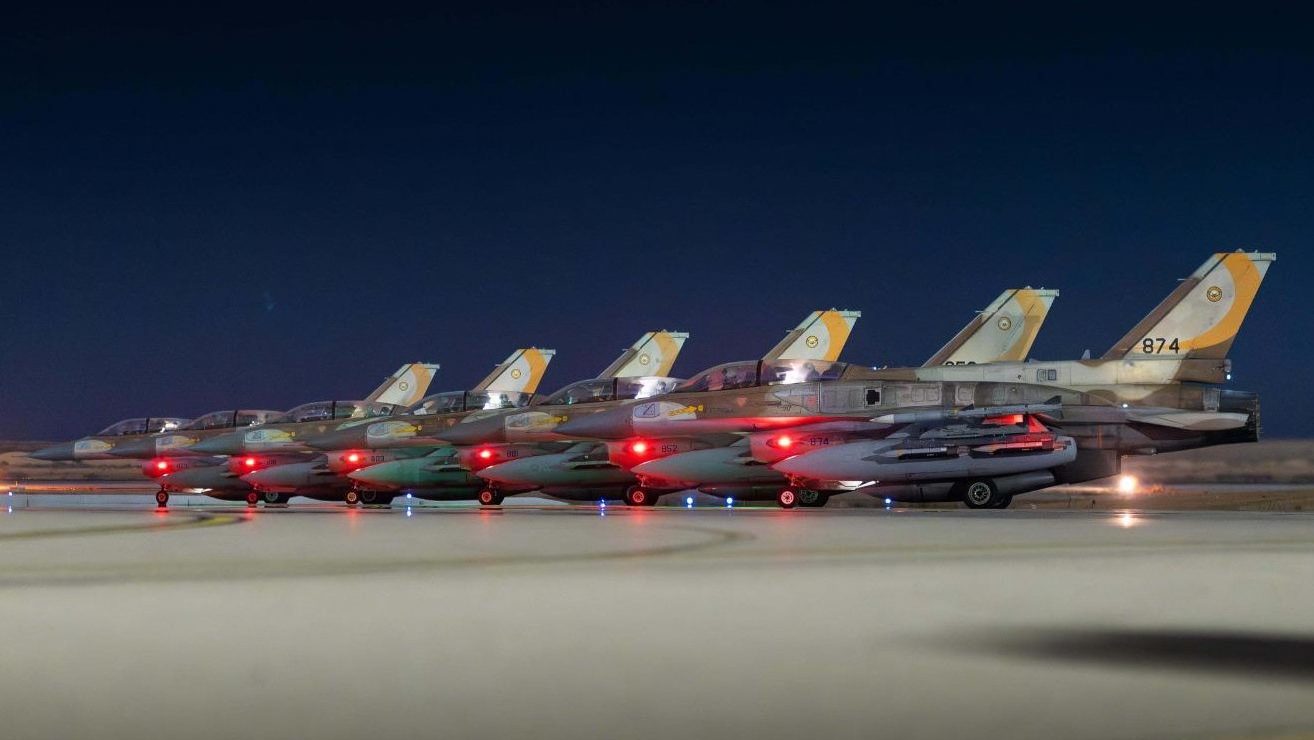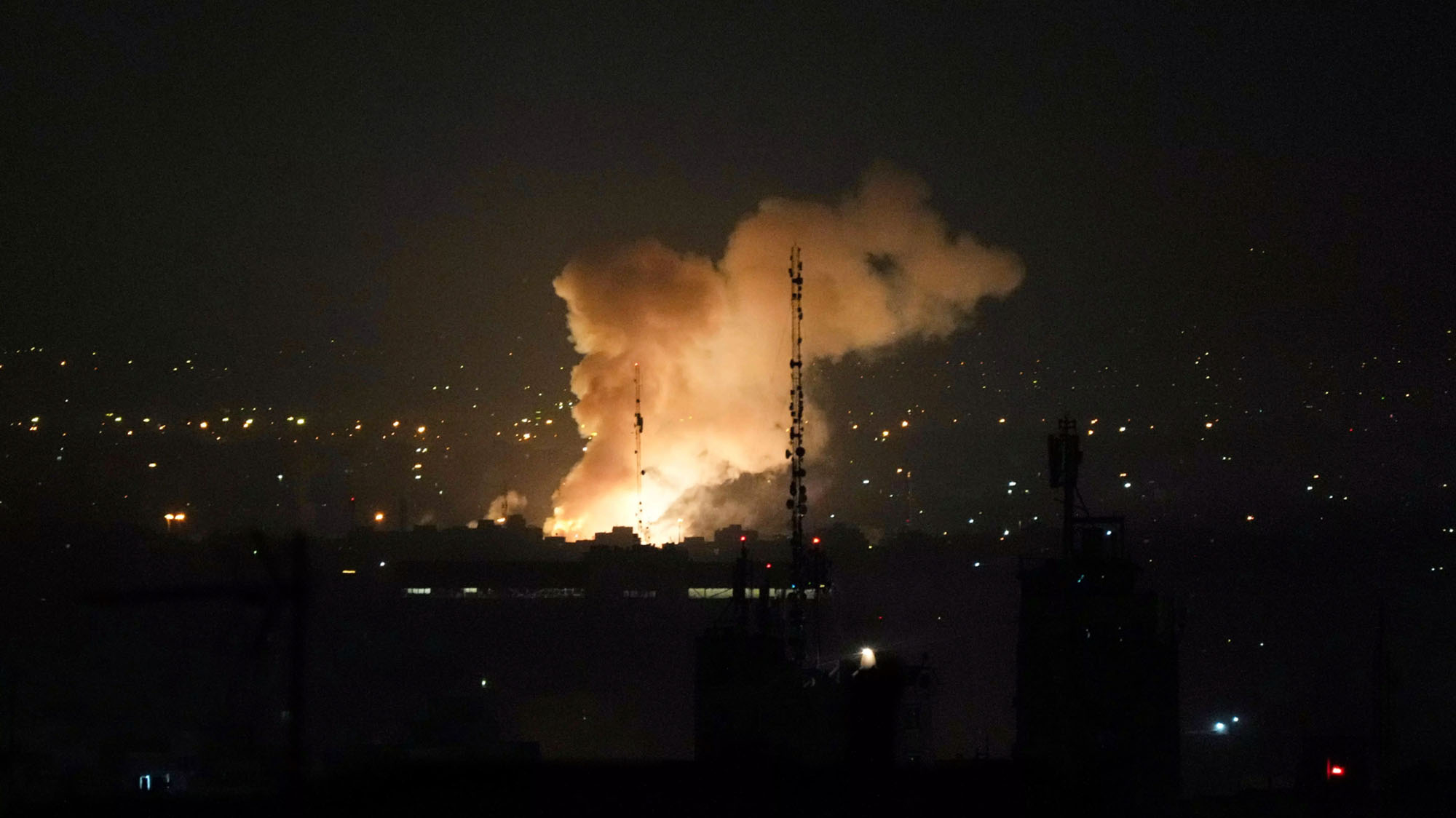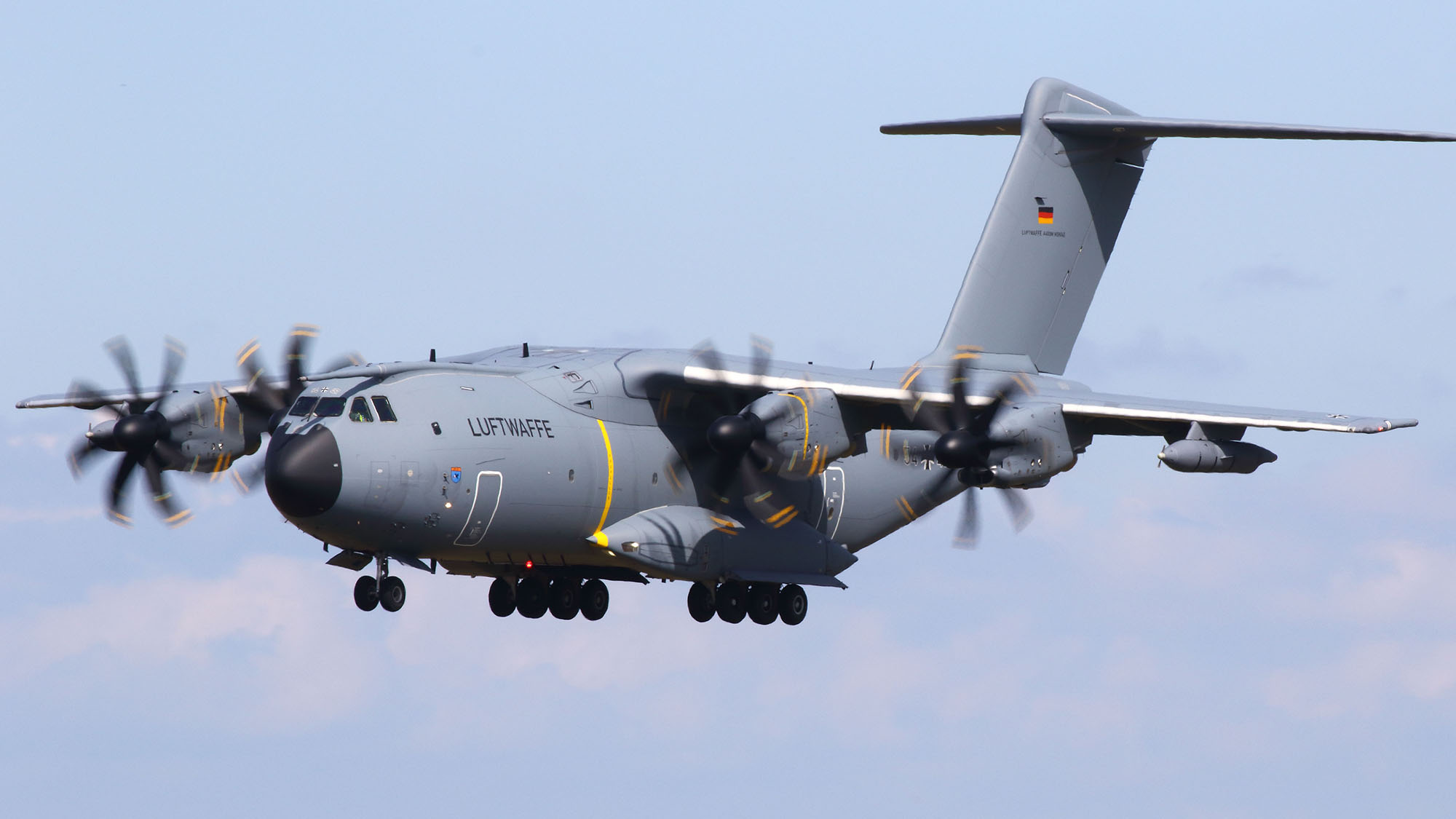Houthis have previously used modified Scud missiles to strike Israel: Exclusive analysis
Missile analyst Ralph Savelsberg explains how the Houthis have managed to modify their Scud missiles with enough range to get inside Israeli territory.


A missile fired by the Houthis in Yemen that reportedly hit the roof of a house in an Israeli settlement south of East Jerusalem, in Jerusalem on January 14, 2025. The missile is removed by Israeli police with a crane. (Photo by Saeed Qaq/Anadolu via Getty Images)
Ansar Allah, the formal name for Yemen’s Houthi movement, started launching ballistic missiles at Israel shortly after the start of the Gaza war in 2023, claiming to support the Palestinians. To date, there have been more than 60 attacks.
Although Ansar Allah likes to give the impression that they are using advanced hypersonic missiles, wreckage of Houthi missile boosters that landed in Israel shows that many of their missiles are variants of the (in)famous Scud missile, originally developed in the Soviet Union in the late fifties. And while Ansar Allah is a known operator of Scud variants, its most common variant, the Zulfiqar, has a maximum range of 1,400 km (869.9 miles) — not enough to reach Israel.
So, what is going on? It appears the Houthi group has developed an upgrade to give their Scuds an extra boost.
A new analysis of missile wreckage indicates that Ansar Allah is using a new Scud variant with a smaller reentry vehicle than the Zulfiqar and likely a smaller payload. Using a technical analysis of Scud variants, based on computer simulations and image and video analysis, we found that to fly the 2,000 km required to reach central Israel, the missile also likely has significantly longer tanks.
These changes reduce its military effectiveness, but its main goal seems to be to simply demonstrate that Ansar Allah can reach Israel.
Ansar Allah’s first recorded ballistic missile attack on Israel occurred in late October 2023. The attacks were paused briefly from mid-January to mid-March 2025, during the Gaza ceasefire, but have continued since, despite Israeli, British and US airstrikes on Yemen. Initially, most of the attacks targeted Eilat, in the south of Israel. This required the missiles to fly about 1,700 km. In the following months, attacks shifted to central Israel and, more recently, even to Haifa, in the very north. This requires missiles with a range close to 2,000 km.
So far, the damage has been limited. Some of the Houthi missiles failed in flight. Others were intercepted by missile defenses, with Israel using Arrow-2 and Arrow-3 interceptors and the US deploying a THAAD missile defense system to the country. However, in three reported cases, missile reentry vehicles (RVs) detonated on the ground. These include an attack on Ben Gurion Airport in May of this year, but prior to this, Dec. 19 and 21 of 2024, RVs destroyed an empty school building and hit a playground in Tel Aviv.
In propaganda about their attacks, Ansar Allah specifically refers to using the Zulfiqar. It is the missile also used in their previous longest-ranged attacks on Dammam on the Saudi Persian Gulf coast in 2021 and on Abu Dhabi in 2022. This missile is also known as the Burkan-3 and is a development of the Burkan-2H, with a decreased payload and larger propellant tanks.
Based on an analysis by the UN Panel of Experts on Yemen, the Burkan-2H is a variant of the Iranian Qiam. This, in turn, is a development of the originally Soviet Scud missile. When the Zulfiqar was unveiled, in 2019, there was no known Iranian equivalent. (Iran paraded a version called the Rezvan through Tehran in 2022, with a claimed maximum range of 1,400 km.)
If Ansar Allah’s propaganda is to be believed, they also use a solid-propellant missile called Palestine-2, which they claim is a hypersonic missile with a maximum range of 2,150 km. In general, hypersonic means faster than five times the speed of sound (depending on the altitude, this is about 1.7 km/s in air). However, any ballistic missile with a range above roughly 1,200 km reaches that speed. The Houthis have also displayed a weapon known as the Tufan, their equivalent of the Iranian liquid-propellent Ghadr with a diameter of 1.25 m and a maximum range of 1,950 km.
Both those weapons seemed like prime candidates to be used against Israel, given the distance. But that does not appear to be the case.

Propellant tank outside Tzur Hudassah in September 2024. (Israeli Police via Facebook)
Part of a propellant tank of a liquid-propellant missile that landed outside Jerusalem, in September 2024, has a diameter that clearly is smaller than 1.25 m. Furthermore, in January 2025, the engine of another missile landed near Jerusalem, and its size and details of its combustion chamber, such as the attachment points for trusses that transfer the thrust to the missile airframe, show that it is a Scud engine. Other wreckage is similar.
These missiles are clearly Scud variants rather than a Tufan or a Palestine-2. This leaves the obvious question of how Ansar Allah can possibly fly a Scud to a range of 2,000 km.
Harder, Better, Faster, Stronger
To increase the range of a missile like the Scud (with a given propellant combination and engine), the fraction of the take-off mass taken up by the propellant should be maximized. This can be done by decreasing the missile’s payload, by building a lighter airframe, reducing the mass of other missile components (such as the gyroscopes and accelerometers used to steer the missile during its boost phase), and by increasing the size of the propellant tanks.
To increase the range of a missile like the Scud (with a given propellant combination and engine), the fraction of the take-off mass taken up by the propellant should be maximized. This can be done by decreasing the missile’s payload, by building a lighter airframe, reducing the mass of other missile components (such as the gyroscopes and accelerometers used to steer the missile during its boost phase), and by increasing the size of the propellant tanks.
Iraq did some of this almost 40 years ago, under Saddam Hussein. The original Scud-B had a range of 300 km with a 1,000 kg warhead. Iraqi AlHusayn missiles were built by lengthening a Scud’s tanks and halving its payload, thereby doubling the range. During the 1991 Gulf War, Iraq lobbed dozens of these missiles at Israel and Saudi Arabia. The Iranian Qiam also combines multiple such changes. It has a significantly lighter airframe with longer tanks and more compact guidance, navigation and control (GNC) systems, as well as a smaller payload. Consequently, it can fly more than 700 km with a 750 kg RV. An earlier analysis of the Burkan-2H used in Houthi attacks on Riyadh in 2019 showed that its range likely was increased even more, to about 950 km, by further reducing its payload to 500 kg.

Scud variants plus reconstructions. (Ralph Savelsberg, based on images from FARS and propaganda images of the Houthi missiles from Ansar Allah)
To find out how the range can be increased, we first evaluate whether the Zulfiqar can plausibly fly 1,400 km, as claimed for the Rezvan. Based on its 0.88 m diameter, it is 11.0±0.8 m long. A video of a Zulfiqar launch is used to measure its take-off acceleration, using the missile’s length and the video framerate. Combining this measurement with the thrust of a Scud engine at the likely launch altitude (Northern Yemen has a high elevation) results in a take-off mass of 6,550 kg.
The final step is to find how much propellant is needed to fly such a missile to a 1,400 km range. This is done by simulating maximum-range trajectories as a function of the booster dead-weight mass fraction, whilst keeping the propellant mass flow and the missile take-off mass the same. The booster deadweight mass fraction is the missile booster’s mass at burnout as a fraction of the booster’s mass on take-off. A decreasing booster dead-weight mass fraction thus means that more of the booster’s take-off mass consists of propellant, increasing the range.

Simulated Zulfiqar range as a function of the booster dead-weight mass fraction. (Ralph Savelsberg)
The simulation results show that, with a 250 kg reentry vehicle, a 1,400 km range requires a booster dead-weight mass fraction of 14.2 percent. This is plausible. The original Scud missile had a significantly higher fraction, but advanced liquid-propellant missiles, like the Soviet R-27 / SS-N-6 “Serb,” had a booster dead-weight mass fraction of about 11 percent. The propellant mass required for this range is about 5.4 tons, which takes up a volume that closely matches the estimated propellant tank volume based on the missile’s size.

Qiam and Zulfiqar masses compared. (Ralph Savelsberg)
The 250 kg RV mass is an estimate, but were to be significantly heavier the booster burnout mass would have to be smaller than the Qiam’s to allow it to fly 1400 km. However, the Zulifqar’s propellant tanks are about 1 m longer, so the Zulfiqar’s booster is likely to be heavier than the Qiam’s.
While it is plausible that the Zulfiqar can fly 1,400 km, this falls short of the distance seen in the Israeli strikes. So, what possible changes can be made to get it to fly further? Most likely is the route followed to develop the Qiam and Zulfiqar. Wreckage found in Israel suggests that the front end of some of the Houthi Scuds differs from the Zulfiqar’s. The base of the Zulfiqar’s RV has a smaller diameter than its booster, with a short distinctive conic section between them. Despite being badly mangled, a Houthi missile booster that landed on a rooftop in Israel clearly has a longer conic section with a smaller front diameter. This suggests it carried a smaller RV with a smaller mass. Furthermore, in late April, photographs emerged of an RV and part of the conic section being recovered by the IDF, using a bulldozer. Comparing it to the size of the bulldozer shows this RV indeed is significantly smaller than that used on the Zulfiqar.

Contour plots of the simulated range as a function of the added propellant tank length, for different booster dead-weight mass fractions. (Ralph Savelsberg)
For an otherwise unchanged Zulfiqar booster, with a dead-weight mass fraction of 14.2 percent, reducing the RV mass to 100 kg results in a range of 1,656 km — closer, but not there yet. Launching from high elevations would increase this range enough to reach Eilat, but solely reducing the RV mass is not enough to fly 2,000 km.
So, to hit the distance, it likely also requires longer tanks. A series of trajectory simulations was done for a lighter and smaller 100 kg RV, for Scud missiles with longer tanks and different booster dead-weight fractions. Based on the comparison between the Zulfiqar and the Qiam, adding a meter to the tank length adds 822 kg of propellant. Since much of the missile’s burnout mass is associated with components whose mass stays the same if the airframe is lengthened, such as the GNC equipment, the engine and its turbopumps, lengthening the tanks does result in a reduction in the associated booster dead-weight mass fraction. (The exact dead-weight mass fraction for the new lengthened missile is unknown, but at burnout the booster is unlikely to be lighter than the Zulfiqar. Thus, combinations of added lengths and dead-weight fractions that result in a smaller burnout mass are excluded.)
Results show that with a 100 kg RV, ranges of 2,000 km (and a little more) are possible with added tank lengths of at least 1.5 m and a dead-weight fraction of 12 percent or less. For a heavier 150 kg RV, the added tank length would have to be more than 2 m and the dead-weight fraction less than 11.3 percent. This is light, but these are plausible numbers.
Of course, there is a limit to how much a missile’s range can be extended by adding length to the tanks without also strengthening the airframe or increasing pressurization of the tanks. In any case, the lengthened missile is likely to be quite flimsy, which may account for some of the missiles’ in-flight failures. The reduction in payload further reduces the missile’s military effectiveness. However, military effectiveness seems far less important to Ansar Allah than demonstrating that they can reach Israel.
That they are using Scud variants obviously does not mean that they have not also used either the Tufan or Palestine-2 in their attacks — but right now there simply is no evidence that they have. Under the right circumstances, even a souped-up Scud can penetrate Israel’s missile defenses, no matter how good those defenses may be.
Ralph Savelsberg, a member of the Breaking Defense Board of Contributors, is associate professor at the Netherlands Defence Academy in Den Helder, specializing in missile defense. This article is based on a paper presented by the author at the 3AF IAMD conference, in Thessaloniki, Greece, on 15 May 2025. It does not reflect any official position or policy of the Government of the Netherlands. The author would like to thank James Kiessling for his valuable comments and suggestions and Mehran Atashjameh for bringing images of the RV to his attention.


















































































































































